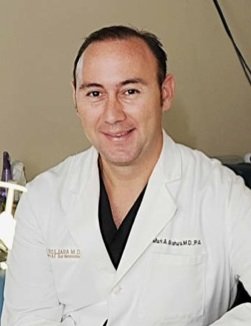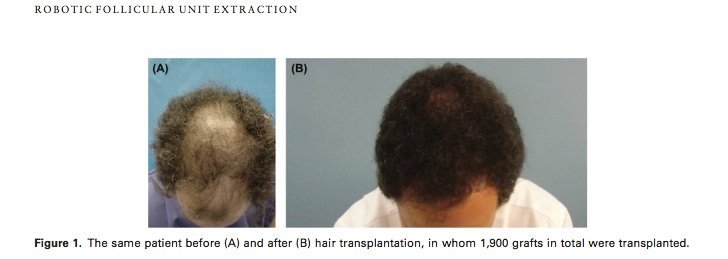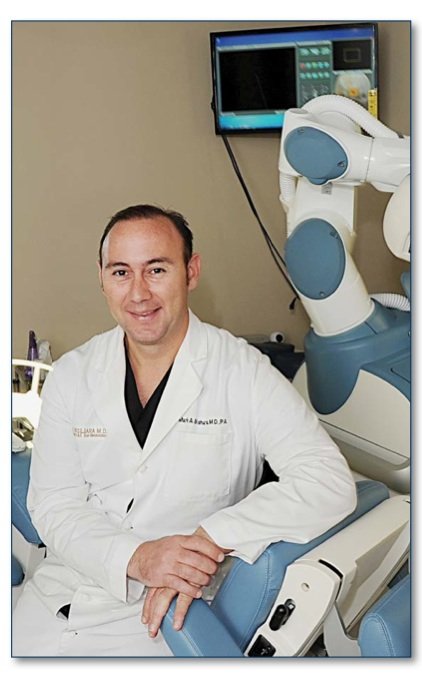Recently, Restoration Robotics launched ARTAS Hair Studio. This state of the art product allows the patient and surgeon plan and produce a simulation of a possible outcome. Although this product has some limitations to the realistic look of the transplanted hair, it does allow for a formal interaction between the surgeon and the patient that spawns more thought into the over- all operative goal and leads to increased numbers of hairs being transplanted.
The most common cause of dissatisfaction of hair transplant patients in my practice and in patients that come to me from other practices is that they didn’t get the thickness that they wanted. The ARTAS Hair Studio allows the patient to “Test Drive” their appearance and modify the operative plan under the guidance of the surgeon. It becomes the surgeon’s ethical and responsible role to provide guidance on safe and age appropriate hairline design, donor capacity, and realistic expectations on social and physiologic downtime. The ARTAS Hair Studio becomes paramount providing a sneak preview to esthetic results that vary with amount of hair.
Put together with a well informed consult discussing preventative hairless measures backed by randomized double-blinded placebo controlled trials, the ARTAS Hair Studio is quickly becoming the standard of care in hair restoration planning and patient education.
ARTAS Hair Studio also integrates directly with the robot and becomes the operative plan for the patient ensuring that the patient is receiving exactly what he is intending to recieve.
For a consultation please call 817-473-2120 or email [email protected]. Skype and other internet-based consultations are available.
Mark A Bishara M.D., P.A. and Paragon Hair Clinics care for patients world-wide.
Dr. Mak A Bishara, M.D. P.A. performs robotic follicular unit graft selection for residents living around Mansfield, Southlake, Dallas, Arlington, Fort Worth, and surrounding the DFW area in North Texas.
How many hairs come out of a graft area?
Is it harder to transplant African American hair? Does it take to the new site as well? Does it take longer? Have you performed any transplants on African Americans?
Please give us a call 817-473-2120 or email us at [email protected]
What is a Robotic Hair Transplant?
 A robotic hair transplant is a type of hair restoration procedure where donor hair is removed directly from the back and sides of the scalp using robotic control. The specific type of hair transplant where robotic technology is used is called follicular unit extraction (FUE). In FUE, a small, round instrument, or punch, is use to separate individual follicular units (naturally occurring groups of 1-4 hairs) from the surrounding tissue, so that they can be extracted and then implanted into the balding area. This process is very tedious and exacting and when done manually often leads to significant injury to the follicles.
A robotic hair transplant is a type of hair restoration procedure where donor hair is removed directly from the back and sides of the scalp using robotic control. The specific type of hair transplant where robotic technology is used is called follicular unit extraction (FUE). In FUE, a small, round instrument, or punch, is use to separate individual follicular units (naturally occurring groups of 1-4 hairs) from the surrounding tissue, so that they can be extracted and then implanted into the balding area. This process is very tedious and exacting and when done manually often leads to significant injury to the follicles.
Robotic surgery allows this procedure to be done in a more precise and consistent way, ultimately maximizing the growth of the grafts. In a robotic hair transplant, follicular units are extracted one at a time by the image-guided, computer-driven system called ARTAS, a technology developed by the company Restoration Robotics. At The Paragon Plastic Surgery & Med Spa, all Follicular Unit Extraction (FUE) procedures employ the speed and precision of the robotic system.
How Does the ARTAS Robotic Procedure Differ from Other Hair Transplant Procedures?
There are two basic types of hair transplant procedures, Follicular Unit Transplantation (FUT or strip surgery) and Follicular Unit Extraction (FUE). In FUT, donor hair is harvested by removing a long thin strip from the back of the scalp. Individual follicular units are then obtained from this strip using stereo-microscopic dissection. In FUE, individual follicular units are harvested directly from the donor area using a sharp, round cutting instrument. The ARTAS Robotic Hair Transplant system performs the follicular unit isolation step of an FUE procedure and can also create recipient sites according to specifications determined by the hair restoration surgeon. In performing each of these steps, the robot uses its image-guided technology to locate the next target and position the cutting instrument, and it does so with precision and speed that cannot be accomplished using manual FUE techniques or instruments.
Hair restoration information is available in our office. Please contact us at 817.473.2120 to schedule an appointment. You can also visit our website at www.MarkBisharaMD.com.


Marc R. Avram, MD,* and Shannon A. Watkins, MD†
BACKGROUND In recent years, there has been a shift toward minimally invasive procedures. In hair trans- plantation surgery, this trend has manifested with the emergence of follicular unit extraction (FUE). Recently, a robot has been introduced for FUE procedures.
OBJECTIVE- To determine the transection rate of a robotic FUE device. In the attached article, the authors discuss the procedure, technical requirements, optimal candidates, advantages, and disadvantages of robotic FUE compared with the standard ellipse.
RESULTS- Optimal candidates for robotic FUE are those with dark hair color who can sit for 45 to 120 minutes and are willing to shave a large area for donor harvesting. The main advantages of robotic FUE compared with the standard ellipse are its minimally invasive nature and the lack of a linear scar.
CONCLUSION- The robot is a new and innovative method for FUE hair transplantation of which hair transplant surgeons should be aware.
Over the past several years, the focus of discussion in the field has begun to shift away from the size of the graft used to transplant hair toward the harvesting method used to obtain the donor grafts. For decades, 2 to 4 mm punch trephines were used to obtain donor hair from the posterior scalp. Typically, the grafts were removed and wounds were allowed to heal by secondary intention. This resulted in widespread “hon- eycomb” scarring (Figure 2). In 1994, the concept of elliptical donor harvesting, also known as strip har- vesting, was introduced and has been the standard method for obtaining donor grafts.3 It is based on the same dermatologic surgery techniques used in removing nevi, skin carcinomas, and cysts. It allows efficient harvesting of hundreds to thousands of fol- licular groupings. As with any cutaneous excision, there is a scar created from removing the donor ellipse. For the majority of patients, this is neither a medical nor a cosmetic issue. For a minority of patients, medical and cosmetic challenges may arise. A small percentage of patients will develop hyper- trophic or broad scars. Others feel limited in the hair styling options because of the donor scar. For these
The concept of follicular unit extraction (FUE) was introduced in the early 21st century and refined over the past decade.4–6 Follicular unit extraction used the same concept of using a steel trephine to harvest donor hair, but instead of being 2 to 4 mm in diameter as was used in the past, the FUE punches range from 0.8 mm to 1.2 mm. This technique is a natural extension of the concept of follicular unit hair transplantation—the utilization of individual follicular groupings in the recipient and donor sites.
Challenges of this technique include the following: increased risk of transection of hair follicles, operator fatigue when harvesting hundreds of follicular groupings, and appropriate spacing of harvested grafts to yield the maximum amount of donor hair without creating the appearance of a depleted donor density.6 Throughout the posterior scalp, the angle of hair growth varies, which presents a challenge to surgeons. Magnification and excellent lighting reduce but do not eliminate the risk of transecting follicles. Compounding this challenge is the need to remove dozens to many hundreds of follicular groupings for each case. Harvesting larger numbers of grafts can result in increased operator fatigue and a higher rate of transected hair follicles. Some experienced sur- geons are able to harvest large numbers of follicular groupings with minimal transections, but others are unable to do so.
Robotic Follicular Unit Extraction

Technical Aspect

Dr. Bishara’s office locations in Mansfield and Southlake, TX have also added this important step in the Follicular Unit Extraction (FUE) procedure, a step that until now needed to be performed by hand. The goal of the new function is for the robot to automatically obtain the maximum number of donor hairs with the least amount of wounding and the greatest cosmetic benefit for the patient. Dr. Bishara is the only doctor in Texas that offers Graft Site Selection.
How Does it Work?
Using robotic graft selection, the hair restoration surgeon programs the ARTAS robot to harvest follicular units which contain two or more hairs by selectively skipping over the 1-hair units. Using its advanced optical guidance system, the robot orients itself to the scalp by way of special markings on a tensioner, a plastic frame-like device that is positioned on the donor area. The software then rapidly analyzes each graft and selects the appropriate ones for extraction. It then dissects these follicular units from the surrounding scalp tissue.
The Importance of Graft Selection in FUE
In FUE hair transplant procedures, the surgeon wants to harvest as much donor hair as possible while leaving the fewest number of wounds. To minimize the number of wounds, you would want to extract only the units that contain the largest amount of hair. However, smaller grafts of 1-hair are typically needed to create a natural-looking hairline and temples. By selecting and extracting larger grafts first, and then extracting smaller ones only as needed, surgeons can both minimize wounding and harvest an adequate number of follicular units of varying size so as to enhance the cosmetic benefit of the procedure. Smaller grafts can be generated by dividing the larger grafts without increasing the donor wounding.
This News is brought to you courtesy of Dr. Bishara and The Paragon Plastic Surgery & Med Spa





